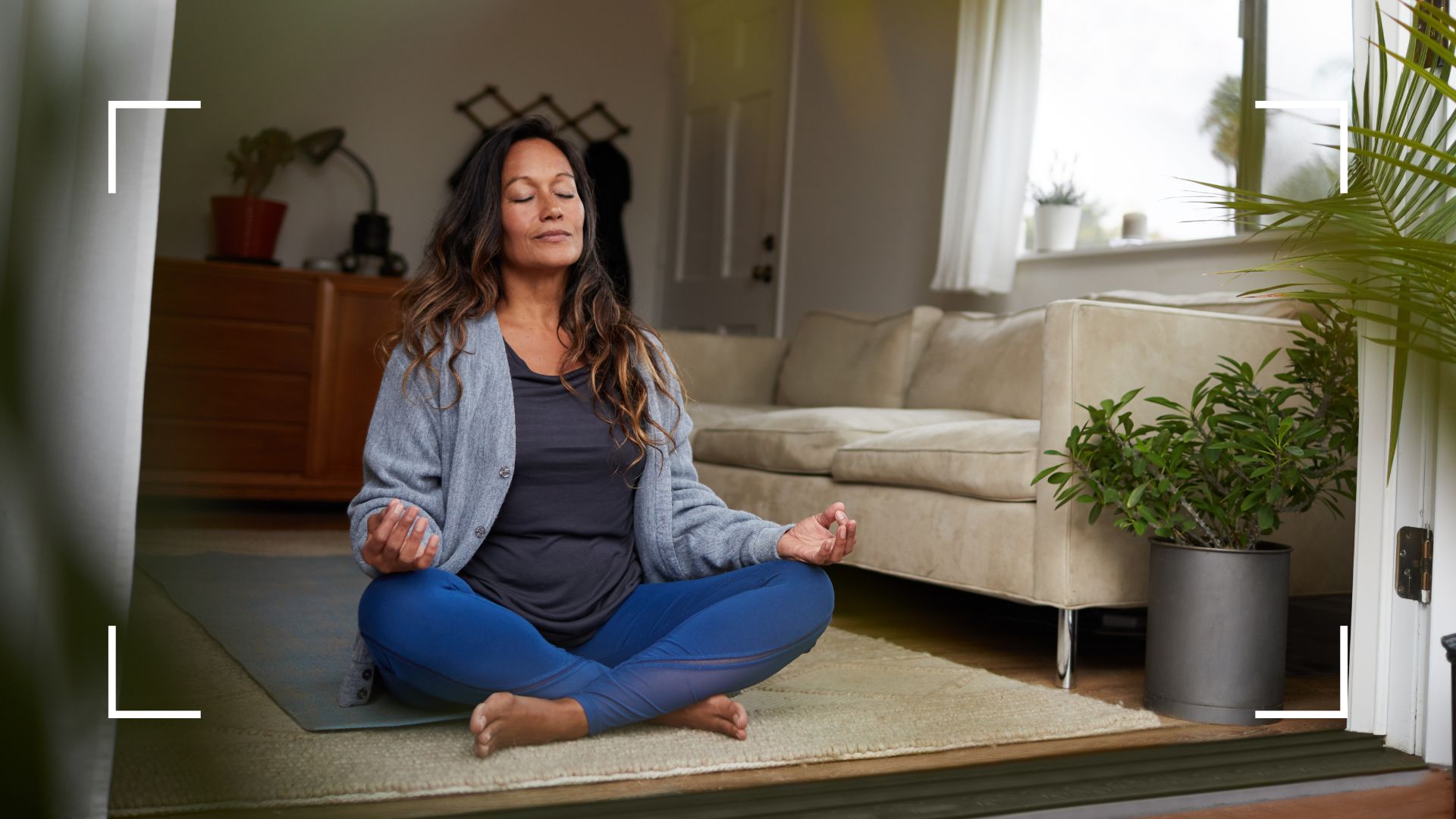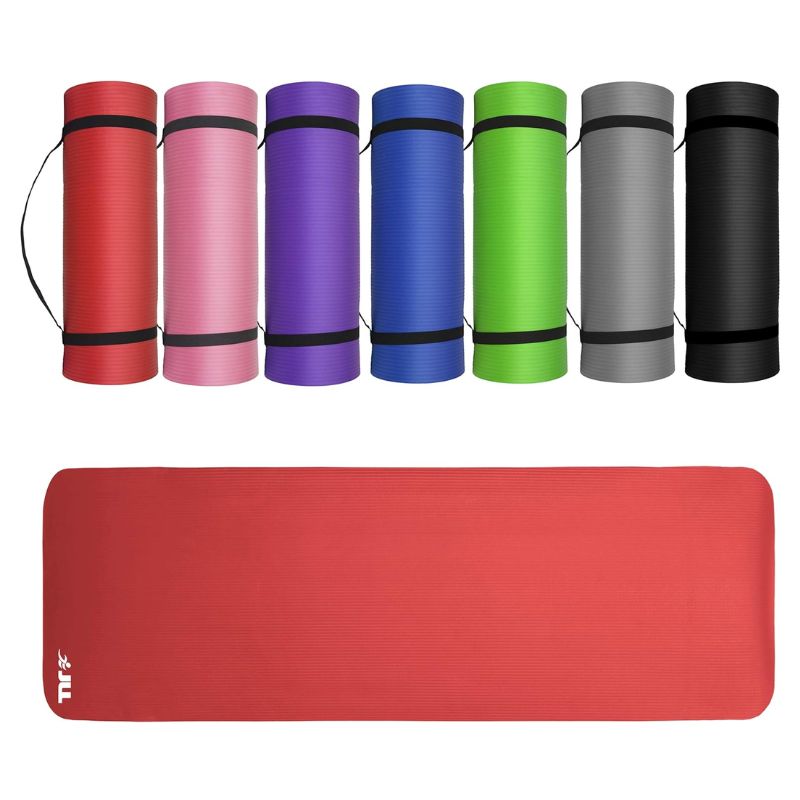Yoga over 50: This 6-move routine takes just 15 minutes and helps to improve your flexibility and maintain muscle mass
Doing yoga over 50 for the first time comes with so many benefits, here the experts reveal how to get started


Yoga over 50 in brief:
1. Mountain pose
2. Chair pose
3. Cat cow
4. Four limbed staff pose
5. Child's pose
6. Legs up the wall
Doing yoga over 50 can have so many benefits, from improving your flexibility to helping maintain muscle mass through menopause.
But taking up a yoga routine doesn't have to take all morning. There's no need to commit yourself to hours of practice every week - even just 15 minutes a day or 30 minutes every other day can make a difference. There's also minimal equipment required as well, all you need is a pick of the best yoga mats or best thick yoga mats if you need a little more support to get started as well.
"Increasingly, women are being told that they need to exercise and to start strength training to boost mental and physical health as they age. The problem is: what if you haven't been exercising regularly for years? Now in your 50s, how and where are you supposed to know where to start? That’s where yoga can help," says Libby Stevenson, a certified yoga teacher specialising in menopause support. So, whether you're totally new to exercise and looking to try yoga mat workouts or want to extend your practice, here's what the experts want you to know about doing yoga over 50.
A 15-minute routine for those new to yoga over 50
Mountain pose
After a gentle but dynamic warm-up to stretch out, you're ready to begin your daily yoga routine. Mountain pose is the perfect starting position, says personal trainer Christianne Wolff, as it "improves posture and alignment, strengthens the thighs, knees, and ankles, and promotes a sense of grounding and stability."
Time: 2 minutes
How to do it:
- Stand with your feet hip-width apart, arms by your sides, and weight evenly distributed on both feet.
- Engage your thighs, lift your chest, and roll your shoulders back and down.
- Extend your arms along your body with palms facing forward.
- Look straight ahead and breathe deeply.
One of the many benefits of yoga is that it's so much more than an exercise - "it's breathing techniques, meditation, and stillness," says Stevenson. So take your time with each exercise, moving through them slowly with big, deep breaths.
Sign up to our free daily email for the latest royal and entertainment news, interesting opinion, expert advice on styling and beauty trends, and no-nonsense guides to the health and wellness questions you want answered.

Christianne Wolff is a multi-award-winning, bestselling author of 7 books in The Body Rescue Plan series. She is a qualified personal trainer, Astanga and Hatha Yoga instructor, healer and pilates teacher, and a nutritionist to the stars.
Chair pose
"A simple but challenging movement," says Stevenson, who also teaches yoga on the Owning Your Menopause app. "It uses body weight to strengthen the muscles and bones of the hips, glutes, and legs, helps to maintain healthy knees and ankles, and it's gentle on joints."
Time: 2.5 minutes
How to do it:
- Come to standing with feet touching, breathe in and lift your arms.
- Breathe out, bend the ankles, knees and hips to come to a seated position.
- Arms remain raised, palms face each other, and the fingers are spread.
- Keep chest lifted with the shoulders back and down and keep arms by your ears.
To move on from this position while doing yoga as a workout, Stevenson suggests: "Inhale and straighten your legs, exhale and lower your arms."
Libby Stevenson is a leading women’s yoga instructor, wellbeing expert and influencer. She is a therapeutic wellbeing practitioner and a yoga instructor for women at different stages of life: from pregnancy to postnatal and all the way to the menopause, working with the Own Your Menopause app.
Cat cow
From here, move slowly from the standing position to the mat. Cat-Cow (Marjaryasana-Bitilasana) is a pose that enhances flexibility and mobility in the spine, says Wolff, who is also the founder of The Body Rescue Plan. "It also strengthens the core muscles, reduces tension in the back, and promotes relaxation," she says.
Time: 2.5 minutes
How to do it:
- Start on your hands and knees in a tabletop position, with wrists directly under shoulders and knees under hips.
- Inhale as you arch your back, dropping your belly towards the mat, lifting your tailbone, and looking up (Cow Pose).
- Exhale as you round your spine, tuck your chin to your chest, and draw your belly button toward your spine (Cat Pose).
- Repeat these movements, flowing between Cat and Cow.
Four limbed staff pose
Staying on all fours on the mat, move into the four-limbed staff pose. A move designed to support your upper body, where the chair pose focuses on the lower body and core, this one focuses on improving strength and flexibility in the triceps, chest, and shoulders for better daily movement.
Time: 2.5 minutes
How to do it:
- Start in a plank position with your hands placed shoulder-width apart.
- Lower your body down, keeping your elbows close to your ribs, until your arms form a 90-degree angle.
- Hold the position for a few breaths, engaging your core and keeping a straight line from head to heels.
5. Child's pose
Maintaining your position on the mat, Child's Pose is the second position to last and it's one of the best yoga stretches for beginners. "This one has a calming effect on the nervous system," says Stevenson. "It can also gently stretch the hips, glutes, spine, and ankles, relieve backache, release tension from the body, and it helps with digestion."
Time: 2.5 minutes
How to do it:
- On your hands and knees, untuck your toes.
- Bring the hips back towards the knees.
- Lengthen your spine forward.
- Bring your forehead onto the mat, place a cushion under your forehead if needed for extra support and comfort.
- Relax your arms into the mat.
To take yourself out of this position and into the final move, "press into your hands and raise your hips to come onto your hands and knees," says the yoga teacher. From here, take a couple of deep breaths before moving.

Legs up the wall
This is a gentle pose for those doing yoga for beginners and cooling down at the end of the routine. Having your legs resting up against the wall improves circulation and reduces swelling in the feet and legs by reversing the effects of gravity, says Stevenson.
"It also stretches your hamstrings, glutes, hips, and lower back, helping to relieve lower back pain," she says. "It calms the nervous system, helps you to de-stress and relax, and quiets a busy mind." The perfect post to end your yoga routine to help you continue your day.
Time: 3 minutes
How to do it:
- Place your yoga mat close to a wall with the short side touching the wall.
- Sit on the mat with the right side of your body facing the wall and your legs bent.
- Slowly lower you back onto the mat while swinging your legs up the wall.
- Adjust your position such that your bottom is close to the wall and the legs are straight and relaxed against the wall.
- Place a cushion under the hips for extra support and comfort.
- Have the arms by your sides with the palms up. Close your eyes. Breathe normally.
"Stay in the pose for as long as it feels good," says Stevenson. "To come out of the pose, bend your knees. Roll over onto one side and, using your arms, push yourself up to sitting."
Why your yoga practice should change with age
In general, the way most women exercise pre- and post-menopause changes. Some do choose to learn how to start running as a beginner at 50 and experience many benefits from this, but others find that painful joints can make this too much of a challenge. Exercise during perimenopause and post-menopause is about finding what works best for you and yoga is a popular choice as it targets problem areas while being softer on bones, muscles, and joints.
"As we age, we lose bone and muscle strength, joints ache, and cognitive function starts to change," says Stevenson. "To stay healthy and continue enjoying a good quality of life, we need to be proactive in our health to counteract the effects of ageing on the body and mind through regular movement, good nutrition, stress management and good quality sleep."
As we age, the focus of physical exercise needs to also change for many women. "It centres on strengthening the bones and muscles through strength training, keeping the heart healthy, and actively working on balance and coordination. All of this helps with cognitive function too."
For the same reason, if you decide yoga isn't for you, it's worth weighing up other options you might prefer. Some women begin weightlifting in their 50s or weigh up Pilates vs yoga and start Pilates for beginners, two other options that centre on the same focus as yoga over 50.

This budget-friendly yoga mat is a must-have for those new to yoga and looking for a little extra support. Especially during menopause, putting pressure on the wrists, ankles, knees, and hips can lead to discomfort, so having a little extra cushioning can be useful. The JLL Yoga Mat offers 15mm of foam comfort.

A yoga block can be an ideal accessory for deepening any yoga stretch. This one from John Lewis is a favourite thanks to its affordable price tag, easy delivery, and ultra-light EVA foam, making storage a dream. It also has bevelled edges so you can place it under your neck and head with total comfort.

Filled with buckwheat or spelt, this organic yoga bolster makes for a great accessory for your growing yoga practice as it can support you during twists, backbends, and forward folds like Child's Pose if your flexibility isn't quite there yet. It's also one of the best wellbeing and self-care gifts for this year.
Tips for doing yoga over 50
- Start where you are: This beginner-friendly workout is a great place to start, but so are classes labelled as 'gentle yoga' or 'beginner's yoga' if you're new to the practice, says Wolff. It's important to take progress slowly and start where your fitness levels currently are, rather than where you want them to be. "Doing so reduces the risk of injury by gradually introducing your body to new movements and allows you to build strength, flexibility, and confidence at a comfortable pace," she says.
- Find a form of yoga that works for you: "There are lots of different types of yoga classes, from chair yoga to meditation classes, complete stillness, yoga nidra, and so on," says Stevenson. "If a traditional yoga class does not suit you then explore the other aspects of it to reap the physical, mental, and emotional benefits of yoga over 50."
- Pay attention to how your body feels: "Respect your limitations and don't push yourself into discomfort or pain," says PT Wolff. "Modify poses as needed, and use props (blocks, straps) for support. Communicate with your instructor about any concerns or physical limitations you may have."

Grace Walsh is woman&home's Health Channel Editor, working across the areas of fitness, nutrition, sleep, mental health, relationships, and sex. She is also a qualified fitness instructor. In 2025, she will be taking on her third marathon in Brighton, completing her first ultra marathon, and qualifying as a certified personal trainer and nutrition coach.
A digital journalist with over seven years experience as a writer and editor for UK publications, Grace has covered (almost) everything in the world of health and wellbeing with bylines in Cosmopolitan, Red, The i Paper, GoodtoKnow, and more.